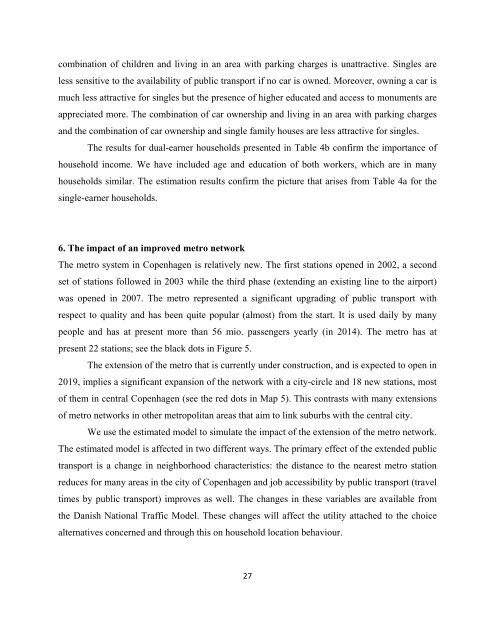Car Ownership? Evidence from the Copenhagen Metropolitan Area
n?u=RePEc:tin:wpaper:20150139&r=dem
n?u=RePEc:tin:wpaper:20150139&r=dem
You also want an ePaper? Increase the reach of your titles
YUMPU automatically turns print PDFs into web optimized ePapers that Google loves.
combination of children and living in an area with parking charges is unattractive. Singles are<br />
less sensitive to <strong>the</strong> availability of public transport if no car is owned. Moreover, owning a car is<br />
much less attractive for singles but <strong>the</strong> presence of higher educated and access to monuments are<br />
appreciated more. The combination of car ownership and living in an area with parking charges<br />
and <strong>the</strong> combination of car ownership and single family houses are less attractive for singles.<br />
The results for dual-earner households presented in Table 4b confirm <strong>the</strong> importance of<br />
household income. We have included age and education of both workers, which are in many<br />
households similar. The estimation results confirm <strong>the</strong> picture that arises <strong>from</strong> Table 4a for <strong>the</strong><br />
single-earner households.<br />
6. The impact of an improved metro network<br />
The metro system in <strong>Copenhagen</strong> is relatively new. The first stations opened in 2002, a second<br />
set of stations followed in 2003 while <strong>the</strong> third phase (extending an existing line to <strong>the</strong> airport)<br />
was opened in 2007. The metro represented a significant upgrading of public transport with<br />
respect to quality and has been quite popular (almost) <strong>from</strong> <strong>the</strong> start. It is used daily by many<br />
people and has at present more than 56 mio. passengers yearly (in 2014). The metro has at<br />
present 22 stations; see <strong>the</strong> black dots in Figure 5.<br />
The extension of <strong>the</strong> metro that is currently under construction, and is expected to open in<br />
2019, implies a significant expansion of <strong>the</strong> network with a city-circle and 18 new stations, most<br />
of <strong>the</strong>m in central <strong>Copenhagen</strong> (see <strong>the</strong> red dots in Map 5). This contrasts with many extensions<br />
of metro networks in o<strong>the</strong>r metropolitan areas that aim to link suburbs with <strong>the</strong> central city.<br />
We use <strong>the</strong> estimated model to simulate <strong>the</strong> impact of <strong>the</strong> extension of <strong>the</strong> metro network.<br />
The estimated model is affected in two different ways. The primary effect of <strong>the</strong> extended public<br />
transport is a change in neighborhood characteristics: <strong>the</strong> distance to <strong>the</strong> nearest metro station<br />
reduces for many areas in <strong>the</strong> city of <strong>Copenhagen</strong> and job accessibility by public transport (travel<br />
times by public transport) improves as well. The changes in <strong>the</strong>se variables are available <strong>from</strong><br />
<strong>the</strong> Danish National Traffic Model. These changes will affect <strong>the</strong> utility attached to <strong>the</strong> choice<br />
alternatives concerned and through this on household location behaviour.<br />
27


